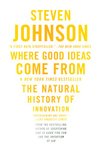
Saved by Harold T. Harper and
Where Good Ideas Come From

Saved by Harold T. Harper and
Reproducing asexually makes perfect sense during prosperous periods: if life is good, keep doing what you’re doing. Don’t mess with success by introducing new genetic combinations. But when the world gets more challenging—scarce resources, predators, parasites—you need to innovate. And the quickest path to innovation lies in making novel connection
... See moreWhen nature finds itself in need of new ideas, it strives to connect, not protect.
The best innovation labs are always a little contaminated.
a paradoxical truth about innovation: good ideas are more likely to emerge in environments that contain a certain amount of noise and error.
Twitter’s creators recognized that there was another kind of competitive advantage that came from complete openness: the advantage that comes from having the largest and most diverse ecosystem of software applications being built on your platform. Call it cooperative advantage. The burden of coming up with good ideas for the product is no longer sh
... See moreit is not merely that weak ties allow information to travel throughout a network more efficiently—that is, without becoming trapped on the remote island of a close-knit group. From the perspective of innovation, it’s even more important that the information arriving from one of those weak ties is coming from a different context, what the innovation
... See moreThe history of being spectacularly right has a shadow history lurking behind it: a much longer history of being spectacularly wrong, again and again. And not just wrong, but messy.
What Ruef discovered was a ringing endorsement of the coffeehouse model of social networking: the most creative individuals in Ruef’s survey consistently had broad social networks that extended outside their organization and involved people from diverse fields of expertise.
Being right keeps you in place. Being wrong forces you to explore.